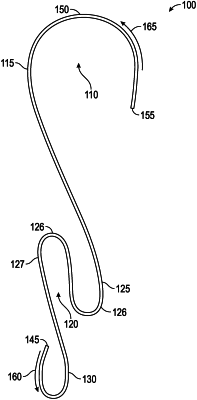| CPC A47G 33/10 (2013.01) [A44B 13/0005 (2013.01)] | 14 Claims |

|
1. An ornament-hanging hook, comprising:
a monolithic filament extending from a proximal end to a distal end,
the monolithic filament comprising an ornament-engaging loop, a first-engagement element, and a second engagement element connected to each of the ornament-engaging loop and the first-engagement element, characterized in that:
the ornament-engaging loop extends from the proximal end to the second-engagement element, the ornament-engaging being characterized as a bottommost portion of the ornament-hanging hook;
the first-engagement element extends from the distal end to the second-engagement element, the first-engagement element having a curved shape such that it can hook around and at least partially engage with a portion of a tree branch or other hanging structure and being characterized as an uppermost portion of the ornament-hanging hook;
and the second-engagement element is disposed between the ornament-engaging loop and the first-engagement element along a length of the monolithic filament, the second-engagement element comprising a plurality of flections including a first flection connected to the ornament-engaging loop and a second flection connected to the first-engagement element, the first flection disposed between the ornament-engaging loop and the second flection along the length of the monolithic filament;
wherein each portion of the first flection is on a same plane as each portion of the second flection;
wherein the ornament-engaging loop and first-engagement element each comprise a curvature path having a same single rotation direction;
wherein while the first-engagement element is positioned upright such that each portion of the ornament-engaging loop is disposed vertically under the first-engagement element, each portion of the first flection is disposed above each portion of the second flection relative to the bottommost and uppermost portions; and
wherein the ornament-hanging hook maintains a substantially vertical orientation when the first flection rests but can freely rotate on a support structure.
|